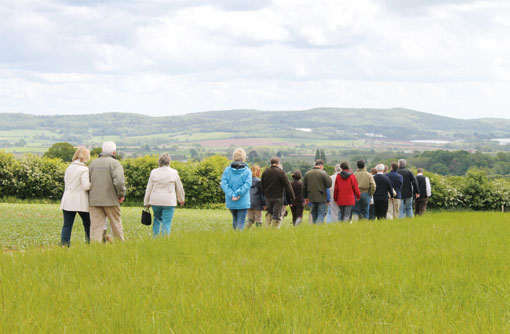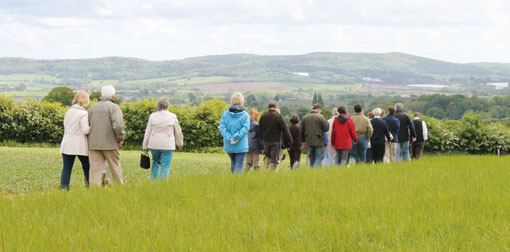Focused on the job at Hereford broiler unit

On a sunny afternoon in May, Rob and Louise Manning played host to the Nuffield Poultry Group on their Hill Farm broiler unit near Ledbury. Philip Clarke reports
Being totally focused on the job in hand, communicating with others in the supply chain and using innovation to the full are the three drivers for business success at Hill Farm in Herefordshire.
Rob Manning has been farming on the 300-acre unit since 1987 – his parents since 1959. “When I came home after a spell in Australia, the main thing on this farm was hops, as well as beef, sheep and cereals,” he recalls.
“But I could see that the future for hops was limited – both because of the disease challenges and because the USA was producing hops far cheaper than we could.
“I wanted another enterprise anyway, and with Sun Valley (now Cargill Meats Europe) in the area, we decided to take a look at broiler production.”
Around 90 acres of arable land was sold and the proceeds used to fund the first of two sheds in 1994, with borrowings providing the finance for the second shed.
The initial stages of producing broilers went well, with regular throughput and secure margins, and in 1997 it was decided to get out of hops altogether and erect another two poultry sheds on the site.
In 2001, Mr Manning embarked on a Nuffield scholarship, looking at integrated beef supply chains, as he was also eager to build up his beef enterprise, supplying Aberdeen Angus to Waitrose.
“As part of that scholarship, I travelled extensively in the USA and visited a lot of feedlots,” he said. “The one thing I really noticed was that they were all totally focused on the one job of producing beef as efficiently as they could.
“I came back, realising that we were trying to do too many things at home and I decided there and then to get rid of all our arable machinery, then the cattle, and just focus on poultry.”
Broiler production now dominates, with four sheds each measuring 80m long by 20m wide, providing space for 31,500 birds which are now grown for Faccenda. That’s 126,000 birds a crop, all in, all out in sheds totalling 6,400sq m.
“We have always tried to be as energy efficient as possible,” says Mr Manning. “For example, all the walls have 4in of insulation and the end fans all have insulated covers. We also have our own 10kW wind turbine that provides us with 10% of our electricity needs.”
Innovation
Innovation is also important and one of the latest investments has been in Heat Recovery Ventilators – air-to-air plate heat exchangers from Guernsey-based Climate Controls.
There are four such HRVs down one side of the shed and they work by transferring heat energy from the outgoing stale air to the incoming fresh air. The incoming air is warmed to about 70% of the temperature of the air going out.
At Hill Farm, when the outside temperature was -5C in the winter and the indoor temperature was 28.5C, fresh air coming into the shed through the HRV was 19C – a temperature rise of 24C.
Each unit can deliver 1,300cu m/hour of warm air. “We are working on about 0.7m cu or 0.8cu m/hour per kilogram of live bird, so that means we have two of the ventilators on for the first four to five days, then all four on for the next four to five days,” says Mr Manning. “After that, we keep them running to day 20, but also bring in the variable speed fans from the other side of the shed.”
Gas savings during the first crop he tried with the new system came to about 30%. “But I was unhappy with the air movement, so I added four Hydor destratification fans to bring the hot air down from the ceiling. I am now seeing about a 40% gas saving.”

Mr Manning acknowledges that some of the large heat exchangers on the market can deliver a bigger gas saving. “But these HRVs are so simple to use, cheap to install and easy to clean. For a retrofit, I think they are better.”
The current retail cost of the HRVs is about £1,580 and running costs are minimal, as they are each powered by two small 100W motors. Mr Manning reckons that, with the current price of gas, the payback time is just three years.
There has been little impact on the litter quality or humidity, he adds. “Initially, we found it a bit more humid in the shed, though the chicks like that. But towards the end the atmosphere got drier.”
Mr Manning says he is far from convinced about the impact heating has on litter quality, anyway. “Basically, after 21 days the birds are drinking about 8,000 litres a day, and about 4,000 litres a day goes on the floor. I think the contribution to humidity from the heaters is a red herring.”
Lighting
As well as ventilation, Mr Manning has also experimented with different lighting arrangements – the third of the four sheds has what he calls “disco lighting”.
“We got to a stage where we needed to change the lights and I’d recently come across some Israeli research which showed that giving the birds green and blue lights in combination could lift meat yield.”
The chicks have both colours on to start with. It is believed that, since they are originally jungle birds, the green light encourages activity, enticing the chicks to explore and find the food and water.
But as they get older, the green lights are turned off and just the blue are left on, which calms them down and means they waste less energy running about.
“They definitely work and we got noticeably extra yield,” says Mr Manning. “I was going to put them into all the other sheds, but there is a question over whether they can consistently meet the minimum of 20 lux required by the Broiler Welfare Directive, so now we are going to look at other lighting options.”
Feeding is another key part of the poultry operation at Hill Farm.
The farm grows as much of its own feed as possible – wheat, which is cultivated on a simple rotation with either oilseed rape, spring beans or spring oats.
The bulk of the feed is delivered by Faccenda, initially crumb, switching to pellets at day 11, based on 55% wheat. This is run through the farm’s own blender.
“I generally add an extra 5% home-produced wheat to the ration in the early stages, rising to 10% with the grower ration. But I have to drop this back down to 5% for the finisher ration, otherwise I could get litter problems.”
The poultry and arable businesses complement each other in other ways. Being in a Nitrate Vulnerable Zone, there is a limit to the amount of nitrogen fertiliser that can be applied, so the chicken manure is usefully applied to the arable ground in the spring.
“I use two crops worth of poultry litter myself, and sell the other five crops to local cereal growers.”
Top performance
The combination of innovative ventilation, lighting and feeding means that Mr Manning is able to achieve above average performance figures.
The Ross birds are currently achieving an FCR of 1.71 and generally get to minimum weight of 1.6kg at about 30 days, at which point they are thinned. The rest go on to a final weight of 2.2kg or 2.3kg, which is reached at 40-42 days.
Mr Manning says that, being involved with the Nuffield poultry group has been a real benefit to his business, opening his eyes to new approaches and giving him the confidence to try them out.
Hill Farm history
Conservation is a hugely important part of farming life for Rob and Louise Manning at Hill Farm. The farm is in the Higher Level Stewardship Scheme, with payments made for maintaining environmental and historic features.
As well as growing bird seed plots and floristically enhanced margins for Natural England, the farm majors on providing public access, actively encouraging visits by local schools and interest groups.
“We don’t take them into the poultry sheds, for obvious biosecurity reasons,” says Mrs Manning. “But it does give us a chance to explain modern poultry production in the context of limiting its impact on the local environment and maintaining biodiversity.”
The farm is of particular interest to the Mormon faith, as there is a pond on the site where one of the church’s first missionaries, Wilford Woodruff, performed a series of baptisms in 1840, converting about 1,800 locals, many of whom then emigrated to the USA.
Around 2,000 visitors a year come to see the pond, which has wheelchair access courtesy of the HLS scheme.
The farm also boasts 50 acres of mixed woodland and the Mannings are currently considering installing a biomass boiler, to use the thinnings and to capture available funds under the Renewable Heat Incentive scheme.
| The Nuffield Poultry Group is an active collection of previous Nuffield scholars with links to the poultry sector. It meets at least twice a year, with a UK study weekend every spring and an autumn overseas study trip which this year is going to Argentina. For more information about the group, contact chairman, Steve Pritchard at steve.pritchard@premiernutrition.co.uk, and for more about the Nuffield scholarship programme, visit www.nuffieldscholar.org |
|---|
